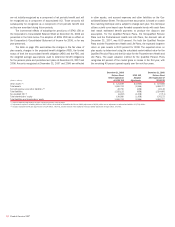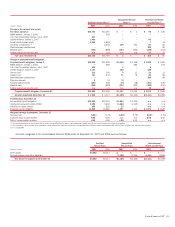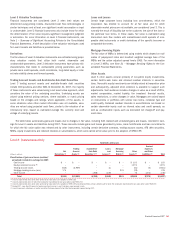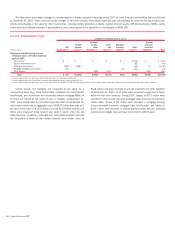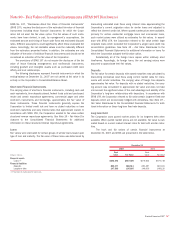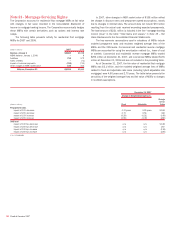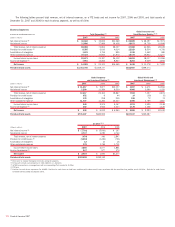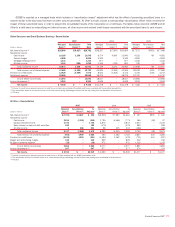Bank of America 2007 Annual Report Download - page 164
Download and view the complete annual report
Please find page 164 of the 2007 Bank of America annual report below. You can navigate through the pages in the report by either clicking on the pages listed below, or by using the keyword search tool below to find specific information within the annual report.
Note 19 – Fair Value Disclosures
Effective January 1, 2007, the Corporation adopted SFAS 157, which pro-
vides a framework for measuring fair value under GAAP. SFAS 157 also
eliminated the deferral of gains and losses at inception of certain
derivative contracts whose fair value was not evidenced by market
observable data. SFAS 157 requires that the impact of this change in
accounting for derivative contracts be recorded as an adjustment to begin-
ning retained earnings in the period of adoption.
The Corporation also adopted SFAS 159 on January 1, 2007. SFAS
159 allows an entity the irrevocable option to elect fair value for the initial
and subsequent measurement for certain financial assets and liabilities
on a contract-by-contract basis. The Corporation elected to adopt the fair
value option for certain financial instruments on the adoption date. SFAS
159 requires that the difference between the carrying value before election
of the fair value option and the fair value of these instruments be recorded
as an adjustment to beginning retained earnings in the period of adoption.
The following table summarizes the impact of the change in account-
ing for derivative contracts described above and the impact of adopting the
fair value option for certain financial instruments on January 1, 2007.
Amounts shown represent the carrying value of the affected instruments
before and after the changes in accounting resulting from the adoption of
SFAS 157 and SFAS 159.
Transition Impact
(Dollars in millions)
Ending Balance
Sheet
December 31, 2006
Adoption Net
Gain/(Loss)
Opening Balance
Sheet
January 1, 2007
Impact of adopting SFAS 157
Net derivative assets and liabilities
(1)
$7,100 $ 22 $7,122
Impact of electing the fair value option under SFAS 159
Loans and leases
(2)
3,968 (21) 3,947
Accrued expenses and other liabilities
(3)
(28) (321) (349)
Other assets
(4)
8,778 – 8,778
Available-for-sale debt securities
(5)
3,692 – 3,692
Federal funds sold and securities purchased under agreements to resell
(6)
1,401 (1) 1,400
Interest-bearing deposit liabilities in domestic offices
(7)
(548) 1 (547)
Cumulative-effect adjustment, pre-tax (320)
Tax impact 112
Cumulative-effect adjustment, net-of-tax, decrease to retained earnings $(208)
(1) The transition adjustment reflects the impact of recognizing previously deferred gains and losses as a result of the rescission of certain requirements of EITF 02-3 in accordance with SFAS 157.
(2) Includes loans to certain large corporate clients. The ending balance at December 31, 2006 and the transition adjustment were net of a $32 million reduction in the allowance for loan and lease losses.
(3) The January 1, 2007 balance after adoption represents the fair value of certain unfunded commercial loan commitments. The December 31, 2006 balance prior to adoption represents the reserve for unfunded lending
commitments associated with these commitments.
(4) Other assets include loans held-for-sale. No transition adjustment was recorded for the loans held-for-sale because they were already recorded at fair value pursuant to lower of cost or market accounting.
(5) Changes in fair value of these AFS debt securities resulting from foreign currency exposure, which is the primary driver of fair value for these securities, had previously been hedged by derivatives that qualified for fair value
hedge accounting in accordance with SFAS 133. As a result, there was no transition adjustment. Following the election of the fair value option, these AFS debt securities have been transferred to trading account assets.
(6) Includes structured reverse repurchase agreements that were hedged with derivatives in accordance with SFAS 133.
(7) Includes long-term fixed rate deposits that were economically hedged with derivatives.
Fair Value Option Elections
Corporate Loans and Loan Commitments
The Corporation elected to account for certain large corporate loans and
loan commitments which exceeded the Corporation’s single name credit
risk concentration guidelines at fair value in accordance with SFAS 159.
Lending commitments, both funded and unfunded, are actively managed
and monitored, and, as appropriate, credit risk for these lending relation-
ships may be mitigated through the use of credit derivatives, with the
Corporation’s credit view and market perspectives determining the size
and timing of the hedging activity. These credit derivatives do not meet the
requirements for hedge accounting under SFAS 133 and are therefore car-
ried at fair value with changes in fair value recorded in other income. Elect-
ing the fair value option allows the Corporation to account for these loans
and loan commitments at fair value, which is more consistent with man-
agement’s view of the underlying economics and the manner in which they
are managed. In addition, accounting for these loans and loan commit-
ments at fair value reduces the accounting asymmetry that would other-
wise result from carrying the loans at historical cost and the credit
derivatives at fair value.
Fair values for the loans and loan commitments are based on market
prices, where available, or discounted cash flows using market-based
credit spreads of comparable debt instruments or credit derivatives of the
specific borrower or comparable borrowers. Results of discounted cash
flow calculations may be adjusted, as appropriate, to reflect other market
conditions or the perceived credit risk of the borrower.
At December 31, 2007, funded loans which the Corporation has
elected to fair value had an aggregate fair value of $4.59 billion recorded
in loans and leases and an aggregate outstanding principal balance of
$4.82 billion. At December 31, 2007, unfunded loan commitments that
the Corporation has elected to fair value had an aggregate fair value of
$660 million recorded in accrued expenses and other liabilities and an
aggregate committed exposure of $20.9 billion. Interest income on these
loans is recorded in interest and fees on loans and leases. At
December 31, 2007, none of these loans were 90 days or more past due
and still accruing interest or had been placed on nonaccrual status. Net
losses resulting from changes in fair value of these loans and loan
commitments of $413 million were recorded in other income during 2007.
These losses were significantly attributable to changes in instrument-
specific credit risk. Following adoption of SFAS 159, approximately $5 mil-
lion of direct loan origination fees and costs related to items for which the
fair value option was elected were recognized in earnings during 2007.
Previously, these items would have been capitalized and amortized to
earnings over the life of the loans.
162
Bank of America 2007




